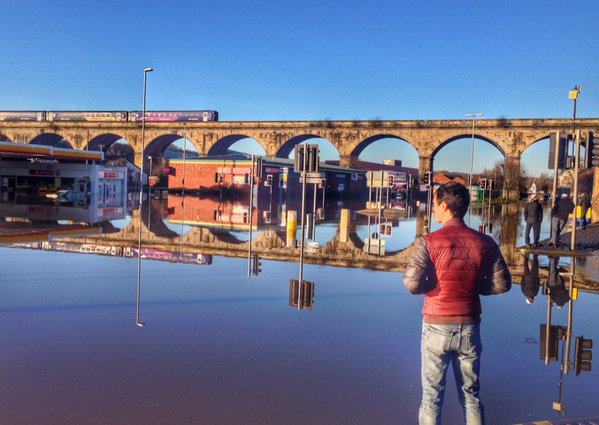A Government decision to reject Leeds council’s flood defence scheme is a ‘kick in the teeth’ for Kirkstall, it’s been claimed.
Leeds West MP Rachel Reeves has hit out at the Government announced what she says are ‘second rate’ proposals for flood defences two and a half years after the River Aire broke its banks and flooded parts of Kirkstall and Burley.

In a letter to council chiefs on Thursday, the Environment Agency put forward an alternative proposal for Phase Two of the Leeds Flood Alleviation Scheme, which falls £47m short of money needed to fund defences that would provide one-in-200-year flood relief. Instead, the proposed scheme offers only a 1-in-75-year level of protection.
Leeds City Council had originally asked for a £112 million investment in the scheme. Its preferred option for Phase Two would have provided increased protection to communities upstream of the city centre, notably in Kirkstall.
Crucially, the Environment Agency’s proposal would not protect against the severity of flooding experienced in 2015.
Leeds West MP Rachel Reeves said businesses and homes could flood again at any time and there is no prospect in sight of that risk being greatly reduced. She added:
“The wholly inadequate, second-rate scheme now being offered falls £47m short of what is needed. It would not protect Leeds against a flood on the same scale as Boxing Day 2015 and provides less than half of the protection offered by the council’s own plan. The Government have broken their promise to the people of Leeds.
“The announcement will do nothing to reassure those affected by the catastrophic 2015 floods that their property and livelihoods are secure.
“It is a kick in the teeth to residents and businesses in Kirkstall who were promised “the right level of flood protection” by the government only two years ago. Ministers, who said they were “fully committed” to ensuring Leeds was properly protected from flooding, have failed to keep their word.”

Ms Reeves said refusing to properly invest in flood defences was a false economy. She added:
“Our changing climate means that major flood events are becoming increasingly common. Damage to homes and businesses resulting from another large flood could far exceed the costs of this scheme. Local firms may also be forced to reconsider their own investment plans and the ability to attract new investment will be curtailed.
“Leeds deserves better than this second-rate plan. It is unacceptable for Leeds to be left in such a vulnerable position.”
Leeds City Council had planned to bolster flood defences between Leeds City centre and Apperley Bridge, by using a combination of natural flood management and engineered measures.
Flood Defence Letter by John Baron on Scribd
But the Environment Agency, which manages the government’s flood defence investments, said that level of investment was ‘not justified’ and offered up to £65 million.
Adrian Gill, area flood risk manager at the Environment Agency said in a statement:
“Working in partnership with Leeds City Council, the Environment Agency is fully committed to reducing the risk of flooding to Leeds.
“Last year, at a cost of £50 million, we saw the completion of the first phase of the Leeds Flood Alleviation Scheme.
“The scheme has reduced the risk of flooding to 3,000 homes, 500 business and 300 acres of development landsouth-east of Leeds Train Station to Woodlesford.
“Since Boxing Day 2015 we have continued to work with Leeds City Council to develop a comprehensive scheme for Leeds taking a catchment wide approach.
“We have recently written to Leeds City Council to confirm our review of their Outline Business Case and will continue to work with them to secure the best possible scheme for Leeds.”


The natural flood management (NFM) part of the proposed scheme, according to Leeds’ own documents, delivers 0% flood protection against 1:200yr floods, for a cost of NFM that is not publicly made available (to my knowledge).
We analysed the proposed scheme as discussed/documented online by LCC executive board (Dec 2017) and its arguments are inconsistent and unclear in various places. Our analysis is written in a language accessible to interested decision-makers and interested public, willing to read more than one-liners:
http://www1.maths.leeds.ac.uk/~obokhove/RSPA_BKK_FEVAirerev.pdf
Also found on eartharxiv
I am afraid that scientific knowledge indeed implies that the 2nd bullet point in the rejection letter is correct. Let’s say planting trees costs 20M, then 112-20=92M and then the shortfall is less.
NFM is too much treated as religion and not analysed thoroughly.
We analyse good and bad NFM in a series of papers, which were known to LCC/EA, including our offer to assist.
2020 updates:
– Evidence entitled “A new tool for communicating cost-effectiveness of flood-mitigation schemes” for the UK Government Department of Environment, Food and Rural Affairs Committee inquiry into flooding.
https://committees.parliament.uk/writtenevidence/9641/pdf/
– Peer-reviewed version of the report with link (ie the one given above in 2018): “A cost-effectiveness protocol for flood-mitigation plans based on Leeds’ Boxing Day 2015 floods”. Water 12(3), 652. I am afraid this 2020 version is more critical and better than the 2018 report: https://www.mdpi.com/2073-4441/12/3/652